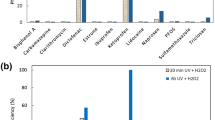Abstract
Developing advanced treatment technologies for improving the removal of micropollutants in water/wastewater is important. A suitable treatment is more likely to be used as the polishing step in the treatment scheme. Advanced oxidation technologies (AOTs) are relevant for removing micropollutants. The ability of direct UV photolysis and selected AOTs to degrade pharmaceuticals, endocrine-disrupting compound and herbicide has been studied and compared. The tested methods resulted in the degradation of the studied micropollutants; however, none of the methods was preferred for the removal of all tested compounds. The UV-active processes have strong potential for removal of the studied micropollutants. The utilisation of a moderate hydrogen peroxide admixture resulted in a more reliable treatment.





Similar content being viewed by others
References
APHA (American Public Health Association) (2005) Standard methods for the examination of water and wastewater, 21st edn. American Water Works Association, Water Environment Federation, Washington DC
Baxendale JH, Wilson JA (1957) The photolysis of hydrogen peroxide at high light intensities. Trans Faraday Soc 53:344–356
Directive 2008/105/EC of the European Parliament and of the Council of 16 December 2008
Dulov A, Dulova N, Trapido M (2011) Combined physicochemical treatment of textile and mixed industrial wastewater. Ozone Sci Eng 33:285–293
Dulova N, Trapido M (2011) Application of Fenton’s reaction for food-processing wastewater treatment. J Adv Oxid Technol 14:9–16
Dulova N, Trapido M, Dulov A (2011) Catalytic degradation of picric acid by heterogeneous Fenton-based processes. Environ Technol 32:439–446
Eisenberg GM (1943) Colorimetric determination of hydrogen peroxide. Ind Eng Chem Anal Ed 15:327–328
Homem V, Santos L (2011) Degradation and removal methods of antibiotics from aqueous matrices—a review. J Environ Manag 92:2304–2347
Ikehata K, El-Din MG, Snyder SA (2008) Ozonation and advanced oxidation treatment of emerging organic pollutants in water and wastewater. Ozone Sci Eng 30:21–26
Klamerth N, Rizzo L, Malato S, Maldonado MI, Agüera A, Fernández-Alba AR (2010) Degradation of fifteen emerging contaminants at μg L−1 initial concentrations by mild solar photo-Fenton in MWTP effluents. Water Res 44:545–554
Klavarioti M, Mantzavinos D, Kassinos D (2009) Removal of residual pharmaceuticals from aqueous systems by advanced oxidation processes. Environ Int 35:402–417
Kulik N, Panova Y, Trapido M (2007) The Fenton chemistry and its combination with coagulation for treatment of dye solutions. Sep Sci Technol 42:1521–1534
Legrini O, Oliveros E, Braun AM (1993) Photochemical processes for water treatment. Chem Rev 93:671–698
Méndez-Arriaga F, Torres-Palma RA, Pétrier C, Esplugas S, Gimenez J, Pulgarin C (2008) Ultrasonic treatment of water contaminated with ibuprofen. Water Res 42:4243–4248
Michael I, Rizzo L, McArdell CS, Manaia CM, Merlin C, Schwartz T, Fatta-Kassinos D (2013) Urban wastewater treatment plants as hotspots for the release of antibiotics in the environment: a review. Water Res 47:957–995
Miranda-García N, Suárez S, Sánchez B, Coronado JM, Malato S, Maldonado MI (2011) Photocatalytic degradation of emerging contaminants in municipal wastewater treatment plant effluents using immobilized TiO2 in a solar pilot plant. Appl Catal B Environ 103:294–301
Morasch B, Bonvin F, Reiser H, Grandjean D, De Alencastro LF, Perazzolo C, Chèvre N, Kohn T (2010) Occurrence and fate of micropollutants in the Vidy Bay of Lake Geneva, Switzerland. Part II: micropollutant removal between wastewater and raw drinking water. Environ Toxicol Chem 29:1658–1668
Pignatello JJ, Oliveros E, MacKay A (2006) Advanced oxidation processes for organic contaminant destruction based on the Fenton reaction and related chemistry. Crit Rev Environ Sci Technol 36:1–84
Santos LM, Araújo AN, Fachini A, Pena A, Delerue-Matos C, Montenegro MC (2010) Ecotoxicological aspects related to the presence of pharmaceuticals in the aquatic environment. J Hazard Mater 175:45–95
Satoh AY, Trosko JE, Masten SJ (2007) Methylene blue dye test for rapid qualitative detection of hydroxyl radicals formed in a Fenton’s reaction aqueous solution. Environ Sci Technol 41:2881–2887
Shen YS, Ku Y, Lee KC (1995) The effect of light absorbance on the decomposition of chlorophenols by ultraviolet radiation and UV/H2O2 process. Water Res 29:907–914
Soares A, Guieysse B, Jefferson B, Cartmell E, Lester JN (2008) Nonylphenol in the environment: a critical review on occurrence, fate, toxicity and treatment in wastewaters. Environ Int 34:1033–1049
Zhang Y, Geißen SU, Gal C (2008) Carbamazepine and diclofenac: removal in wastewater treatment plants and occurrence in water bodies. Chemosphere 73:151–1161
Acknowledgments
The financial support provided by institutional research funding IUT (1-7) of the Estonian Ministry of Education and Research and the Estonian Science Foundation (grant 8186) is gratefully acknowledged.
Author information
Authors and Affiliations
Corresponding author
Additional information
Responsible editor: Philippe Garrigues
Rights and permissions
About this article
Cite this article
Trapido, M., Epold, I., Bolobajev, J. et al. Emerging micropollutants in water/wastewater: growing demand on removal technologies. Environ Sci Pollut Res 21, 12217–12222 (2014). https://doi.org/10.1007/s11356-014-3020-7
Received:
Accepted:
Published:
Issue Date:
DOI: https://doi.org/10.1007/s11356-014-3020-7




